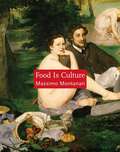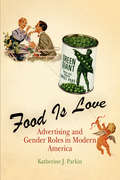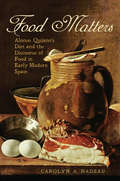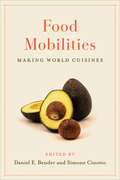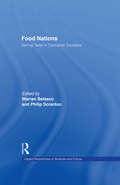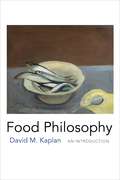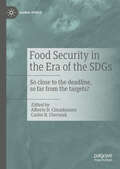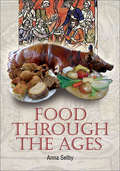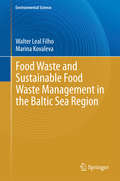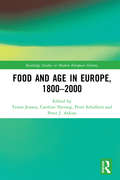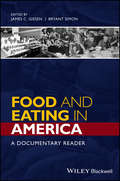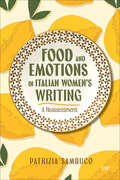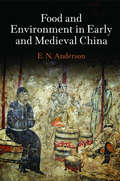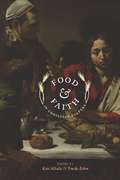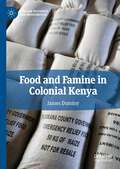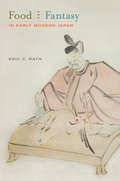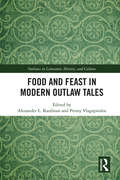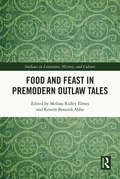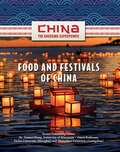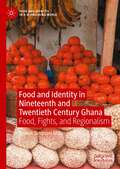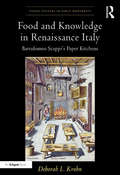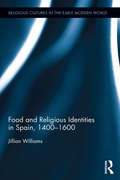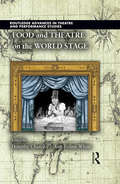- Table View
- List View
Food Is Culture (Arts and Traditions of the Table: Perspectives on Culinary History)
by Massimo MontanariElegantly written by a distinguished culinary historian, Food Is Culture explores the innovative premise that everything having to do with food—its capture, cultivation, preparation, and consumption—represents a cultural act. Even the "choices" made by primitive hunters and gatherers were determined by a culture of economics (availability) and medicine (digestibility and nutrition) that led to the development of specific social structures and traditions.Massimo Montanari begins with the "invention" of cooking which allowed humans to transform natural, edible objects into cuisine. Cooking led to the creation of the kitchen, the adaptation of raw materials into utensils, and the birth of written and oral guidelines to formalize cooking techniques like roasting, broiling, and frying. The transmission of recipes allowed food to acquire its own language and grow into a complex cultural product shaped by climate, geography, the pursuit of pleasure, and later, the desire for health. In his history, Montanari touches on the spice trade, the first agrarian societies, Renaissance dishes that synthesized different tastes, and the analytical attitude of the Enlightenment, which insisted on the separation of flavors. Brilliantly researched and analyzed, he shows how food, once a practical necessity, evolved into an indicator of social standing and religious and political identity. Whether he is musing on the origins of the fork, the symbolic power of meat, cultural attitudes toward hot and cold foods, the connection between cuisine and class, the symbolic significance of certain foods, or the economical consequences of religious holidays, Montanari's concise yet intellectually rich reflections add another dimension to the history of human civilization. Entertaining and surprising, Food Is Culture is a fascinating look at how food is the ultimate embodiment of our continuing attempts to tame, transform, and reinterpret nature.
Food Is Love
by Katherine J. ParkinModern advertising has changed dramatically since the early twentieth century, but when it comes to food, Katherine Parkin writes, the message has remained consistent. Advertisers have historically promoted food in distinctly gendered terms, returning repeatedly to themes that associated shopping and cooking with women. Foremost among them was that, regardless of the actual work involved, women should serve food to demonstrate love for their families. In identifying shopping and cooking as an expression of love, ads helped to both establish and reinforce the belief that kitchen work was women's work, even as women's participation in the labor force dramatically increased. Alternately flattering her skills as a homemaker and preying on her insecurities, advertisers suggested that using their products would give a woman irresistible sexual allure, a happy marriage, and healthy children. Ads also promised that by buying and making the right foods, a woman could help her family achieve social status, maintain its racial or ethnic identity, and assimilate into the American mainstream.Advertisers clung tenaciously to this paradigm throughout great upheavals in the patterns of American work, diet, and gender roles. To discover why, Food Is Love draws on thousands of ads that appeared in the most popular magazines of the twentieth and early twenty-first centuries, including the Ladies' Home Journal, Good Housekeeping, Ebony, and the Saturday Evening Post. The book also cites the records of one of the nation's preeminent advertising firms, as well as the motivational research advertisers utilized to reach their customers.
Food Matters: Alonso Quijano's Diet and the Discourse of Food in Early Modern Spain
by Carolyn A. NadeauIn the second sentence of Don Quixote, Cervantes describes the diet of the protagonist, Alonso Quijano: "A stew made of more beef than mutton, cold salad on most nights, abstinence eggs on Saturdays, lentils on Fridays, and an additional squab on Sundays."Through an inventive and original engagement with this text, Carolyn A. Nadeau explores the shifts in Spain's cultural and gastronomic history. Using cooking manuals, novels, poems, dietary treatises, and other texts, she brings to light the figurative significance of foodstuffs and culinary practices in early modern Spain. Drawing on the work of Pierre Bourdieu and Stephen Mennell, Food Matters reveals patterns of interdependence as observed, for example, in how Muslim and Jewish aversion to pork fired Spain's passion for ham, what happened when New World foodstuffs entered into Old World kitchens, and how food and sexual urges that so often came together, regardless of class, ethnicity, or gender, construct moments of communal celebration.This mouth-watering tour of the discourses of food in early modern Spain is complemented by an appendix that features forty-seven recipes drawn from contemporary sources.
Food Mobilities: Making World Cuisines (Culinaria #1)
by Simone Cinotto Daniel E. BenderBringing together multidisciplinary scholars from the growing discipline of food studies, Food Mobilities examines food provisioning and the food cultures of the world, historically and in contemporary times. The collection offers a range of fascinating case studies, including explorations of Italian food in colonial Ethiopia, traditional Cornish pasties in Mexico, migrant community gardeners in Toronto, and beer all around the world. In exploring the origins of the contemporary global food system and how we cook and eat today, Food Mobilities uncovers the local and global circulation of food, ingredients, cooks, commodities, labour, and knowledge.
Food Nations: Selling Taste in Consumer Societies (Hagley Perspectives on Business and Culture)
by Warren Belasco Philip ScrantonThis original collection abandons culinary nostalgia and the cataloguing of regional cuisines to examine the role of food and food marketing in constructing culture, consumer behavior, and national identity.
Food Philosophy: An Introduction (California Studies In Food And Culture Ser. #39)
by David M. KaplanFood is a challenging subject. There is little consensus about how and what we should produce and consume. It is not even clear what food is or whether people have similar experiences of it. On one hand, food is recognized as a basic need, if not a basic right. On the other hand, it is hard to generalize about it given the wide range of practices and cuisines, and the even wider range of tastes.This book is an introduction to the philosophical dimensions of food. David M. Kaplan examines the nature and meaning of food, how we experience it, the social role it plays, its moral and political dimensions, and how we judge it to be delicious or awful. He shows how the different branches of philosophy contribute to a broader understanding of food: what food is (metaphysics), how we experience food (epistemology), what taste in food is (aesthetics), how we should make and eat food (ethics), how governments should regulate food (political philosophy), and why food matters to us (existentialism). Kaplan embarks on a series of philosophical investigations, considering topics such as culinary identity and authenticity, tasting and food criticism, appetite and disgust, meat eating and techno-foods, and consumerism and conformity. He emphasizes how different narratives help us navigate the complex world of food and reminds us we all have responsibilities to ourselves, to others, and to animals. An original treatment of a timely subject, Food Philosophy is suitable for undergraduates while making a significant contribution to scholarly debates.
Food Provisions for Ancient Rome: A Supply Chain Approach (Studies in Roman Space and Urbanism)
by Paul JamesThis book defines the processes used for delivering a range of food items to the city of Rome and its hinterland from the first century AD using modern supply chain modelling techniques. The subject matter delves into the wider supply of goods, such as wood and building products, to add further perspective to the breadth of the system managed by the Roman administration to ensure supply and political stability. It assesses the impact of strategic changes such as the introduction of water-powered milling technology and restructuring of the annona in this period, as well as administrative reforms. Evidence from ancient sources, both literary and epigraphic, along with relevant archaeological comparative evidence is used to develop a detailed supply model, including the mapping of warehouse management systems; port and river traffic co-ordination; quality control mechanisms and administrative structures. Unlike other contemporary studies, this model takes into consideration supply chain losses to correct the erroneous assumption that supply is equal to consumption. A product flow map from the source of supply to the consumer details the labour, equipment and infrastructure required at each stage, painting a graphic picture of just what an achievement it was for the administration to have maintained such a complex system over this long time period. Food Provisions for Ancient Rome provides an in depth exploration of this topic that will be of interest to anyone working on the city of Rome under the empire, as well as those interested in imperial administration and logistics.
Food Security in the Era of the SDGs: So close to the deadline, so far from the targets? (Global Ethics)
by Alberto D. Cimadamore Carlos B. CherniakThis book addresses the challenges to achieve food security, which can arguably be one of the axis of any transformational solution to the structural production and reproduction of hunger, malnutrition, and poverty. According to the picture depicted in the book, access to sufficient and safe food is not guaranteed for approximately 2.4 billion people, with women and children in rural areas being the most significantly affected. Particularly, the situation concerning children has set off all the alarms. Based on the data offered in the different chapters, the authors estimate that would be very difficult -if not impossible- to achieve the most important global objectives that the international community has committed to achieving by 2030: ending poverty, hunger, and food insecurity. This way, the most ambitious and well-intended development initiative the international community was able to put together in the history of humankind (the Agenda 2030) is derailing. Urgent expansion in the supply of the nutritious foods that constitute a healthy diet and a shift in consumption patterns are required -among other things- to effectively address SDGs targets. The book presents and discusses contributions of authors who have been thinking and facing those challenges in the academia and decision-making spheres. It is also a relevant contribution to rethinking the public policies of Latin American and Caribbean (LAC) countries, as well as the technical cooperation and financial assistance schemes for the region. The rethinking exercise sketched here places LAC both as a critical scenario and as a laboratory for envisioning innovative solutions that have the potential to not only transform the regional reality but also to be replicated in other regions with the proper adaptation to different contexts.
Food Through the Ages: From Stuffed Dormice to Pineapple Hedgehogs
by Anna SelbyThe author of Victorian Christmas “recounts some of the most fascinating—and disgusting—dishes our ancestors used to eat. . . . A must-buy book for foodies” (Fiona Shoop, author of How to Deal in Antiques). With people’s fascination for food increasing, there are more cooking shows and magazines than ever. Medieval banquets are sold-out events and classic recipes and ingredients are back in fashion, which is what this book sets out to explore. Highlighting the advantages and disadvantages of each era from Roman times onwards, Anna Selby recreates classic recipes from Epicurius’s stuffed dormice to recipes that readers really will want to recreate. She explores how trade and improved transportation increased foodstuffs available and reflects on how we’re returning to the old-fashioned notion of seasonal foods—just like our ancestors had to do.
Food Waste and Sustainable Food Waste Management in the Baltic Sea Region
by Walter Leal Filho Marina KovalevaThis work presents the findings of an extensive study on the state-of-the-art regarding the problem of food waste in Belarus, Estonia, Germany, Latvia, Lithuania, Poland and Sweden. The results show that the problem of food waste can be found at different levels in each country and that our knowledge of it is limited by the current lack of studies in the area. The problem is primarily due to food waste generated by the manufacturing sector, mostly in the form of unused or inefficiently used by-products, as well as on a share of food thrown away by households that is still suitable for human consumption. The main reduction/prevention method, applied across the countries, is food donation; the remaining methods are the same ones used for biodegradable waste in the respective countries. The findings gathered in this study show a number of potential measures/methods for sustainable food waste management, which may be considered in future works in order to reduce the amounts of food waste generated in each of the aforementioned countries.
Food and Age in Europe, 1800-2000 (Routledge Studies in Modern European History)
by Tenna Jensen Caroline Nyvang Peter Scholliers Peter J. AtkinsPeople eat and drink very differently throughout their life. Each stage has diets with specific ingredients, preparations, palates, meanings and settings. Moreover, physicians, authorities and general observers have particular views on what and how to eat according to age. All this has changed frequently during the previous two centuries. Infant feeding has for a long time attracted historical attention, but interest in the diets of youngsters, adults of various ages, and elderly people seems to have dissolved into more general food historiography. This volume puts age on the agenda of food history by focusing on the very diverse diets throughout the lifecycle.
Food and Eating in America: A Documentary Reader (Uncovering the Past: Documentary Readers in American History)
by Bryant Simon James C. GiesenGuides students through a rich menu of American history through food and eating This book features a wide and diverse range of primary sources covering the cultivation, preparation, marketing, and consumption of food from the time before Europeans arrived in North America to the present-day United States. It is organized around what the authors label the “Four P’s”—production, politics, price, and preference—in order to show readers that food represents something more than nutrition and the daily meals that keep us alive. The documents in this book demonstrate that food we eat is a “highly condensed social fact” that both reflects and is shaped by politics, economics, culture, religion, region, race, class, and gender. Food and Eating in America covers more than 500 years of American food and eating history with sections on: An Appetizer: What Food and Eating Tell Us About America; Hunting, Harvesting, Starving, and the Occasional Feast: Food in Early America; Fields and Foods in the Nineteenth Century; Feeding a Modern World: Revolutions in Farming, Food, and Famine; and Counterculture Cuisines and Culinary Tourism. Presents primary sources from a wide variety of perspectives—Native Americans, explorers, public officials, generals, soldiers, slaves, slaveholders, clergy, businessmen, workers, immigrants, activists, African Americans, Hispanics, Asian Americans, artists, writers, investigative reporters, judges, the owners of food trucks, and prison inmates Illustrates the importance of eating and food through speeches, letters, diaries, memoirs, newspaper and magazine articles, illustrations, photographs, song lyrics, advertisements, legislative statutes, court rulings, interviews, manifestoes, government reports, and recipes Offers a new way of exploring how people lived in the past by looking closely and imaginatively at food Food and Eating in America: A Documentary Reader is an ideal book for students of United States history, food, and the social sciences. It will also appeal to foodies and those with a curiosity for documentary-style books of all kinds.
Food and Emotions in Italian Women's Writing: A Reassessment (Toronto Italian Studies)
by Patrizia SambucoFood and Emotions in Italian Women’s Writing discusses the relevance of food imagery in the writing of Italian women over a period of one hundred years, from the 1920s to the present day, while offering new ways to narrate women’s history and creativity. In this groundbreaking work, Patrizia Sambuco shows how food imagery in different historical periods challenge established political discourses by conveying unexpressed, alternative, or transgressive emotions. Through literary analysis, archival research, and philosophical approaches to the senses, emotions, and food, the book considers a variety of authors, from the celebrated to the hardly known. Sambuco argues that in different ways, throughout the decades, the conceptual domain of food has helped express forms of selfhood that push the boundaries of womanhood and interact with cultural and political panoramas at national and international levels. Building an alternative history of Italian women and their creativity, Sambuco shows how the interplay of the senses and emotions becomes a profitable way to illuminate overlooked aspects of women’s subjectivity. Food and Emotions in Italian Women's Writing ultimately reassesses women’s writing, giving value to the marginality of women’s bodies and positions through the conceptual domain of food.
Food and Environment in Early and Medieval China (Encounters with Asia)
by E. N. AndersonChinese food is one of the most recognizable and widely consumed cuisines in the world. Almost no town on earth is without a Chinese restaurant of some kind, and Chinese canned, frozen, and preserved foods are available in shops from Nairobi to Quito. But the particulars of Chinese cuisine vary widely from place to place as its major ingredients and techniques have been adapted to local agriculture and taste profiles. To trace the roots of Chinese foodways, one must look back to traditional food systems before the early days of globalization.Food and Environment in Early and Medieval China traces the development of the food systems that coincided with China's emergence as an empire. Before extensive trade and cultural exchange with Europe was established, Chinese farmers and agriculturalists developed systems that used resources in sustainable and efficient ways, permitting intensive and productive techniques to survive over millennia. Fields, gardens, semiwild lands, managed forests, and specialized agricultural landscapes all became part of an integrated network that produced maximum nutrients with minimal input—though not without some environmental cost. E. N. Anderson examines premodern China's vast, active network of trade and contact, such as the routes from Central Asia to Eurasia and the slow introduction of Western foods and medicines under the Mongol Empire. Bringing together a number of new findings from archaeology, history, and field studies of environmental management, Food and Environment in Early and Medieval China provides an updated picture of language relationships, cultural innovations, and intercultural exchanges.
Food and Faith in Christian Culture (Arts and Traditions of the Table: Perspectives on Culinary History)
by Ken Albala Trudy EdenWithout a uniform dietary code, Christians around the world used food in strikingly different ways, developing widely divergent practices that spread, nurtured, and strengthened their religious beliefs and communities. Featuring never-before published essays, this anthology follows the intersection of food and faith from the fourteenth to the twenty-first century, charting the complex relationship among religious eating habits and politics, culture, and social structure.Theoretically rich and full of engaging portraits, essays consider the rise of food buying and consumerism in the fourteenth century, the Reformation ideology of fasting and its resulting sanctions against sumptuous eating, the gender and racial politics of sacramental food production in colonial America, and the struggle to define "enlightened" Lenten dietary restrictions in early modern France. Essays on the nineteenth century explore the religious implications of wheat growing and breadmaking among New Zealand's Maori population and the revival of the Agape meal, or love feast, among American brethren in Christ Church. Twentieth-century topics include the metaphysical significance of vegetarianism, the function of diet in Greek Orthodoxy, American Christian weight loss programs, and the practice of silent eating rituals among English Benedictine monks. Two introductory essays detail the key themes tying these essays together and survey food's role in developing and disseminating the teachings of Christianity, not to mention providing a tangible experience of faith.
Food and Famine in Colonial Kenya (African Histories and Modernities)
by James DuminyThis book offers a genealogical critique of how food scarcity was governed in colonial Kenya. With an approach informed by the ‘analysis of government’, the study accounts for the emergence and persistence of dominant approaches to promoting food security in Kenya and elsewhere in Africa – policies and practices that prioritize increased agricultural production as the principal means of achieving food security. Drawing on a range of archival sources, the book investigates how those tasked with governing colonial Kenya confronted food as a particular kind of problem. It emphasizes the ways in which that problem shifted in conjunction with the emergence and consolidation of the colonial state and economic relations in the territory. The book applies a novel conceptual approach to the historical study of African food systems and famine, and provides the first longitudinal and in-depth analysis of the dynamics of food scarcity and its government in Kenya.
Food and Fantasy in Early Modern Japan
by Eric RathHow did one dine with a shogun? Or make solid gold soup, sculpt with a fish, or turn seaweed into a symbol of happiness? In this fresh look at Japanese culinary history, Eric C. Rath delves into the writings of medieval and early modern Japanese chefs to answer these and other provocative questions, and to trace the development of Japanese cuisine from 1400 to 1868. Rath shows how medieval "fantasy food" rituals--where food was revered as symbol rather than consumed--were continued by early modern writers. The book offers the first extensive introduction to Japanese cookbooks, recipe collections, and gastronomic writings of the period and traces the origins of dishes like tempura, sushi, and sashimi while documenting Japanese cooking styles and dining customs.
Food and Feast in Modern Outlaw Tales (Outlaws in Literature, History, and Culture)
by Penny Vlagopoulos Alexander L. KaufmanThis collection of scholarly essays presents new work from in an emerging line of inquiry: modern outlaw narratives and the textual and cultural relevance of food and feasting. Food, its preparation and its consumption, is presented in outlaw narratives as central points of human interaction, community, conflict, and fellowship. Feast scenes perform a wide variety of functions, serving as cultural repositories of manners and behaviors, catalysts for adventure, or moments of regrouping and redirecting narratives. The book argues that modern outlaw narratives illuminate a potent cross-cultural need for freedom, solidarity, and justice, and it examines ways in which food and feasting are often used to legitimate difference, create discord, and manipulate power dynamics.
Food and Feast in Premodern Outlaw Tales (Outlaws in Literature, History, and Culture #8)
by Melissa Ridley Elmes Kristin Bovaird-AbboIn Food and Feast in Premodern Outlaw Tales editors Melissa Ridley Elmes and Kristin Bovaird-Abbo gather eleven original studies examining scenes of food and feasting in premodern outlaw texts ranging from the tenth through the seventeenth centuries and forward to their cinematic adaptations. Along with fresh insights into the popular Robin Hood legend, these essays investigate the intersections of outlawry, food studies, and feasting in Old English, Middle English, and French outlaw narratives, Anglo-Scottish border ballads, early modern ballads and dramatic works, and cinematic medievalism. The range of critical and disciplinary approaches employed, including history, literary studies, cultural studies, food studies, gender studies, and film studies, highlights the inherently interdisciplinary nature of outlaw narratives. The overall volume offers an example of the ways in which examining a subject through interdisciplinary, cross-geographic and cross-temporal lenses can yield fresh insights; places canonic and well-known works in conversation with lesser-known texts to showcase the dynamic nature and cultural influence and impact of premodern outlaw tales; and presents an introductory foray into the intersection of literary and food studies in premodern contexts which will be of value and interest to specialists and a general audience, alike.
Food and Festivals of China (China: The Emerging Superpower)
by Yan LiaoHave you ever seen the boisterous lion dances or heard the multitude of firecrackers in Chinatown during the Chinese New Year? Did you ever wonder what kind of festivals and holidays the Chinese people celebrate? This book takes a look at the fascinating world of Chinese food and festivals. It introduces the most popular traditional festivals celebrated by Chinese people all over the globe, including the Spring Festival (Chinese New Year), the Dragon Boat Festival, the Mid-Autumn Festival, and two "festivals of the dead." It also examines intriguing ethnic festivals celebrated by some of China's 55 officially recognized minority peoples. Discover the customs, legends, and traditional food and treats of these festivals. Share the excitement of the celebration with one-fifth of the world's population, and enjoy the liveliest component of a 4,000-year-old civilization!
Food and Festivals: India
by Mike HirstINDIA Let your mouth water and your tastebuds tingle as you find out all about Indian food and festivals in this book. Did you know that throwing rice at newlyweds comes from a tradition at weddings in India? Choose which gifts of candies you would like to receive at the festival of Diwali. Try the festival recipes inside to taste the flavor of INDIA.
Food and Identity in Nineteenth and Twentieth Century Ghana: Food, Fights, and Regionalism (Food and Identity in a Globalising World)
by Brandi Simpson MillerThis book investigates how cooking, eating, and identity are connected to the local micro-climates in each of Ghana’s major eco-culinary zones. The work is based on several years of researching Ghanaian culinary history and cuisine, including field work, archival research, and interdisciplinary investigation. The political economy of Ghana is used as an analytical framework with which to investigate the following questions: How are traditional food production structures in Ghana coping with global capitalist production, distribution, and consumption? How do land, climate, and weather structure or provide the foundation for food consumption and how does that affect the separate traditional and capitalist production sectors? Despite the post WWII food fight that launched Ghana’s bid for independence from the British empire, Ghana’s story demonstrates the centrality of local foods and cooking to its national character. The cultural weight of regional traditional foods, their power to satisfy, and the overall collective social emphasis on the ‘proper’ meal, have persisted in Ghana, irrespective of centuries of trade with Europeans. This book will be of interest to scholars in food studies, comparative studies, and African studies, and is sure to capture the interest of students in new ways.
Food and Knowledge in Renaissance Italy: Bartolomeo Scappi's Paper Kitchens (Visual Culture In Early Modernity Ser.)
by Deborah L KrohnThough Bartolomeo Scappi's Opera (1570), the first illustrated cookbook, is well known to historians of food, up to now there has been no study of its illustrations, unique in printed books through the early seventeenth century. In Food and Knowledge in Renaissance Italy, Krohn both treats the illustrations in Scappi's cookbook as visual evidence for a lost material reality; and through the illustrations, including several newly-discovered hand-colored examples, connects Scappi's Opera with other types of late Renaissance illustrated books. What emerges from both of these approaches is a new way of thinking about the place of cookbooks in the history of knowledge. Krohn argues that with the increasing professionalization of many skills and trades, Scappi was at the vanguard of a new way of looking not just at the kitchen-as workshop or laboratory-but at the ways in which artisanal knowledge was visualized and disseminated by a range of craftsmen, from engineers to architects. The recipes in Scappi's Opera belong on the one hand to a genre of cookery books, household manuals, and courtesy books that was well established by the middle of the sixteenth century, but the illustrations suggest connections to an entirely different and emergent world of knowledge. It is through study of the illustrations that these connections are discerned, explained, and interpreted. As one of the most important cookbooks for early modern Europe, the time is ripe for a focused study of Scappi's Opera in the various contexts in which Krohn frames it: book history, antiquarianism, and visual studies.
Food and Religious Identities in Spain, 1400-1600 (Religious Cultures in the Early Modern World)
by Jillian WilliamsIn the late fourteenth century, the Iberian Peninsula was home to three major religions which coexisted in relative peace. Over the next two centuries, various political and social factors changed the face of Iberia dramatically. This book examines this period of dynamic change in Iberian history through the lens of food and its relationship to religious identity. It also provides a basis for further study of the connection between food and identities of all types. This study explores the role of food as an expression of religious identity made evident in things like fasting, feasting, ingredient choices, preparation methods and commensal relations. It considers the role of food in the formation and redefinition of religious identities throughout this period and its significance in the maintenance of ideological and physical boundaries between faiths. This is an insightful and unique look into inter-religious dynamics. It will therefore be of great interest to scholars of religious studies, early modern European history and food studies.
Food and Theatre on the World Stage (Routledge Advances in Theatre & Performance Studies)
by Ann Folino White Dorothy ChanskyPutting food and theatre into direct conversation, this volume focuses on how food and theatre have operated for centuries as partners in the performative, symbolic, and literary making of meaning. Through case studies, literary analyses, and performance critiques, contributors examine theatrical work from China, Japan, India, Greece, Italy, France, Germany, England, the United States, Chile, Argentina, and Zimbabwe, addressing work from classical, popular, and contemporary theatre practices. The investigation of uses of food across media and artistic genres is a burgeoning area of scholarly investigation, yet regarding representation and symbolism, literature and film have received more attention than theatre, while performance studies scholars have taken the lead in examining the performative aspects of food events. This collection looks across dramatic genres, historical periods, and cultural contexts, and at food in all of its socio-political, material complexity to examine the particular problems and potentials of invoking and using food in live theatre. The volume considers food as a transhistorical, global phenomenon across theatre genres, addressing the explosion of food studies at the end of the twentieth century that has shown how food is a crucial aspect of cultural identity.
